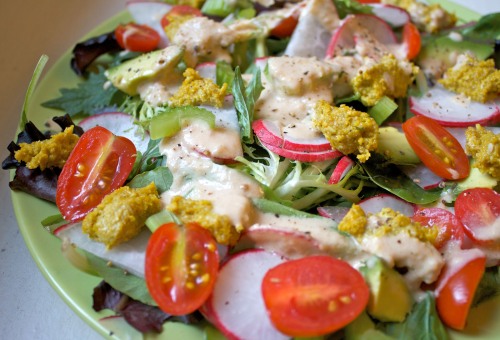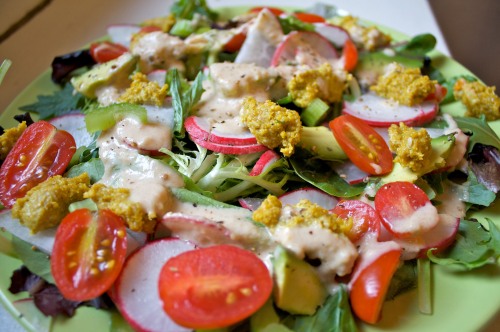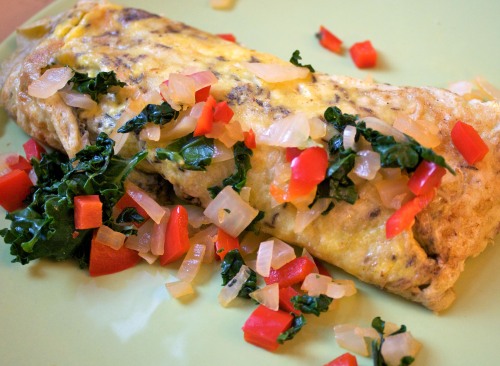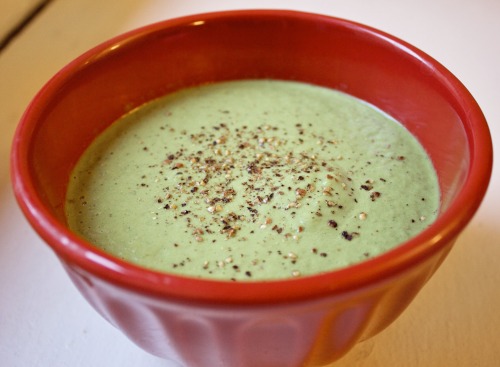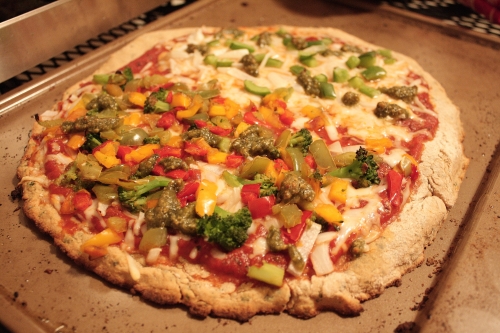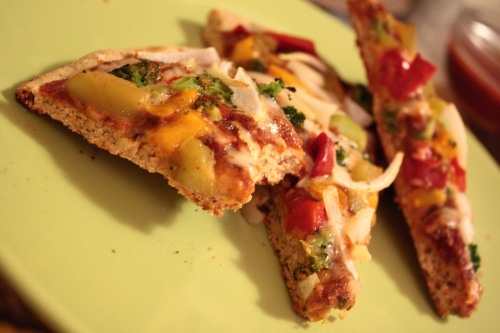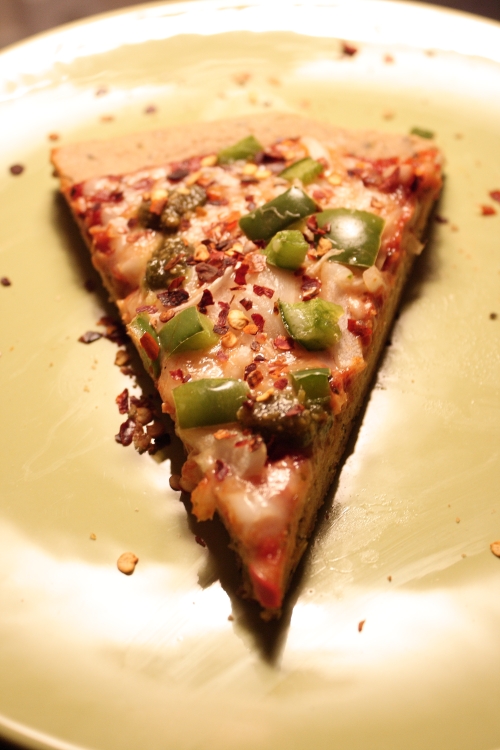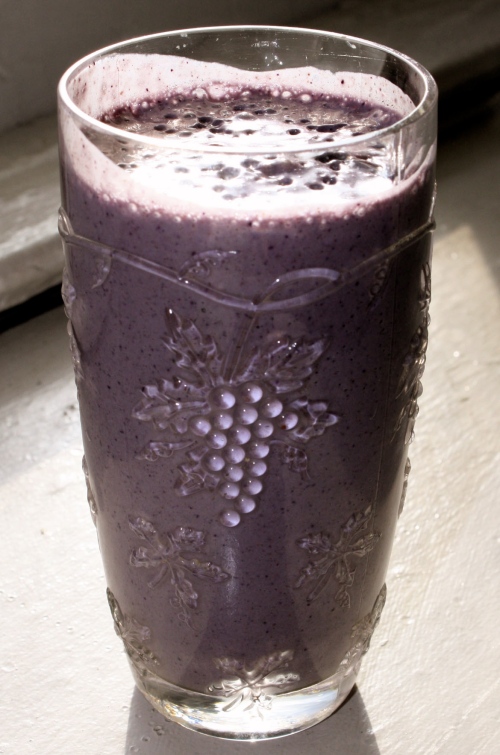The past three years, I’ve had the honor of making Thanksgiving dinner. Not surprisingly, I always strive to make a healthy meal that still reflects the style and aesthetic of traditional Thanksgiving cuisine. My meals are always vegetarian, but this meal was vegan (with the exception of one dessert that uses organic eggs), partially raw, and almost entirely grainless. My food always uses no refined or unnatural sweeteners or artificial ingredients. Everything is from scratch (with the exception of one dessert where I use a pre-made pie crust). I didn’t follow a recipe for everything, but I’ll give you a basic idea of how to re-create these dishes.
Dinner
Raw Vegan Stuffing
Process raw sunflower seeds and almonds (or any other raw nuts or seeds) in the food processor. Add chopped onion, grated carrot, chopped celery, chopped apple, chopped button mushrooms, and fresh sage, thyme, and basil. Add olive oil and sea salt to taste, combine well, and dehydrate in a food dehydrator (I use Excalibur) at 110 degrees for about six hours, stirring every few hours. Dehydrating isn’t completely necessary, but it gave this stuffing a very authentic texture.
Sautéed Collard Greens
Add chopped onion to a pan with olive oil. Once onions are slightly browned, add finely chopped collard greens and some water to the pan and cover it. Adding water allows the collard greens to steam. Since collard greens are so dense, they need more time to cook than most greens.
Roasted Vegetables
Pre-heat oven to 350F degrees. Cut and peel butternut squash, turnip, red pepper, onion, asparagus, and brussell sprouts to uniform-sized pieces. Coat in olive oil, sea salt, and fresh or dried herbs of choice (rosemary, thyme, etc). Put most dense vegetables (squash, brussell sprouts) in the oven first, followed by onion, peppers, asparagus. Stir vegetables after about 10 minutes to insure browning; continue to cook to desired darkness.
Raw Mashed “Potatoes” (Parsnips)
 Combine parsnips, pine nuts (or other nut), water, lemon juice, 1-2 cloves of garlic, sea salt, and a drizzle of olive oil in a high-powered blender (I use Vita-Mix) or food process. Process until smooth. Warm in the dehydrator if desired.
Combine parsnips, pine nuts (or other nut), water, lemon juice, 1-2 cloves of garlic, sea salt, and a drizzle of olive oil in a high-powered blender (I use Vita-Mix) or food process. Process until smooth. Warm in the dehydrator if desired.
Raw Mushroom Gravy
 Great on mashed parsnips, raw stuffing, or anything else. Combine shiitake mushrooms, raw almonds, garlic, water, olive oil, and fresh sage in a high-powered blender or food processor.
Great on mashed parsnips, raw stuffing, or anything else. Combine shiitake mushrooms, raw almonds, garlic, water, olive oil, and fresh sage in a high-powered blender or food processor.
Raw Cauliflower “Rice”
 This dish has a texture similar to couscous. Break apart a large head of cauliflower and place in large, heat-safe bowl. Pour boiling water to cover and let sit for about one minute. Drain, then add cauliflower, garlic, basil, sea salt, olive oil, and turmeric to a food processor and process until a rice-like consistency is reached.
This dish has a texture similar to couscous. Break apart a large head of cauliflower and place in large, heat-safe bowl. Pour boiling water to cover and let sit for about one minute. Drain, then add cauliflower, garlic, basil, sea salt, olive oil, and turmeric to a food processor and process until a rice-like consistency is reached.
Mashed Sweet Potatoes with Coconut Milk
 Steam or boil sweet potatoes (I prefer garnet yams) until tender. Mash, add about a half can of coconut milk, and continue mashing over low heat. Season with cinnamon and sea salt.
Steam or boil sweet potatoes (I prefer garnet yams) until tender. Mash, add about a half can of coconut milk, and continue mashing over low heat. Season with cinnamon and sea salt.
Cranberry Sauce
 I adapted this recipe from Clean Eating Magazine. Add 12 oz fresh cranberries, 1 chopped apple, 1/2 cup raw agave nectar (or raw honey), 1/2 cup water, 1 1/2 TBS minced fresh ginger, juice of 1/2 large lemon, and 1/8 tsp sea salt to a saucepan. Bring to a boil, then let simmer for 8 to 10 minutes. Stir often and allow to cool completely before serving. I found it wasn’t quite sweet enough for my liking, so I added a bit more agave and a few drops of liquid stevia.
I adapted this recipe from Clean Eating Magazine. Add 12 oz fresh cranberries, 1 chopped apple, 1/2 cup raw agave nectar (or raw honey), 1/2 cup water, 1 1/2 TBS minced fresh ginger, juice of 1/2 large lemon, and 1/8 tsp sea salt to a saucepan. Bring to a boil, then let simmer for 8 to 10 minutes. Stir often and allow to cool completely before serving. I found it wasn’t quite sweet enough for my liking, so I added a bit more agave and a few drops of liquid stevia.
Dessert
Raw Cacao (Chocolate) Mud Pie
 This recipe is a bit elaborate, but this pie is exquisite. It tastes like flourless chocolate cake but is made from incredibly healthful ingredients.
This recipe is a bit elaborate, but this pie is exquisite. It tastes like flourless chocolate cake but is made from incredibly healthful ingredients.
For the crust:
– 2 cups raw nuts (walnuts and pecans)
– 1 cup dates
– 2 cups unsweetened shredded coconut
– 1/2 cup raw cacao powder
– 4 TBS agave nectar
Process dates and nuts in food processor; add other crust ingredients until well-blended. Press into a springform pan and chill in the refrigerator.
For the filling:
– 1 cup coconut oil
– 2 small/medium avocados
– 1 cup cacao powder
– 1/2 cup agave nectar
– a few drops liquid stevia
– 1 tsp vanilla extract
Blend all filling ingredients without overmixing. Add to crust, top with shredded coconut, and allow to chill in fridge for a few hours before serving.
Raw Apple Crisp
 Chop gala apples and coat in a mixture of lemon juice, coconut oil, agave, maple flavoring, cinnamon, and almond milk or water. Let soften in dehydrator at 110 degrees for a few hours, or serve apples raw. The crisp topping is adapted from Ani’s Raw Food Kitchen by Ani Phyo. In a food processor, lightly process 3/4 cup pecans, 1/8 tsp salt, and 1/2 tsp cinnamon. Add 1/2 cup chopped dates, 1 tsp vanilla extract, and 2 TBS coconut oil and process. Add topping to apples.
Chop gala apples and coat in a mixture of lemon juice, coconut oil, agave, maple flavoring, cinnamon, and almond milk or water. Let soften in dehydrator at 110 degrees for a few hours, or serve apples raw. The crisp topping is adapted from Ani’s Raw Food Kitchen by Ani Phyo. In a food processor, lightly process 3/4 cup pecans, 1/8 tsp salt, and 1/2 tsp cinnamon. Add 1/2 cup chopped dates, 1 tsp vanilla extract, and 2 TBS coconut oil and process. Add topping to apples.
Flourless Gingerbread
 Ingredients:
Ingredients:
– 1 cup almond butter (roasted is fine)
– 4 organic eggs
– pinch salt
– 1 tsp baking soda
– 1 tsp vanilla extract
– 1 TBS maple flavor
– 2 TBS powdered ginger, 1 TBS cinnamon
– 1 TBS agave
– 1/4 tsp strong stevia powder
Combine all ingredients well. Line a loaf pan with parchment paper (very important!) and bake at 325F degrees for about 20 minutes.
Pumpkin Pie
 Ingredients:
Ingredients:
– 1 pre-made spelt pie crust
– 1 cup canned pumpkin
– 1 large carrot
– 3/4 cup almond milk
– 2 TBS tapioca starch (or other thickener)
– 3 TBS coconut oil
– 1/4 tsp strong stevia powder or natural sweetener of choice
– pumpkin pie spice to taste, dash sea salt
Blend all filling ingredients in blender, pour into crust, bake at 375F degrees for about 30 minutes. Let cool completely before serving (even stick it in the fridge).
Desserts were served with cashew cream, combining 1 cup cashews, 1/2 cup almond milk, and a few drops liquid stevia in the blender.

And there you have my Thanksgiving dinner! I’m still enjoying the leftovers. I hope you all had a wonderful, happy holiday.
Eat well,
Emily





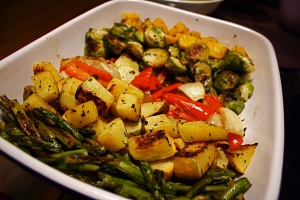
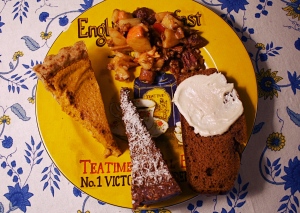
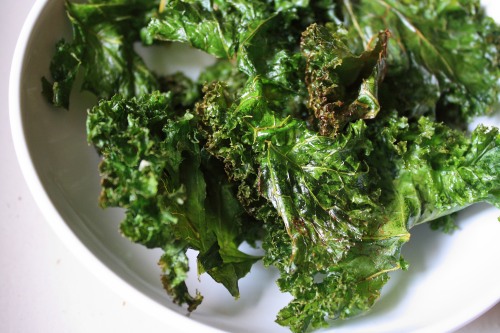
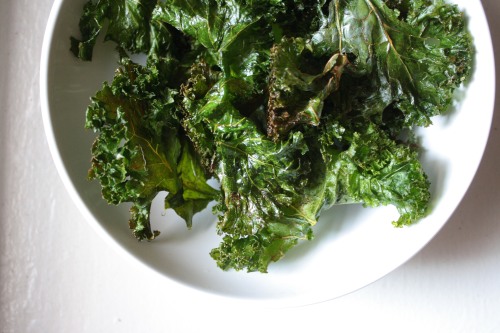

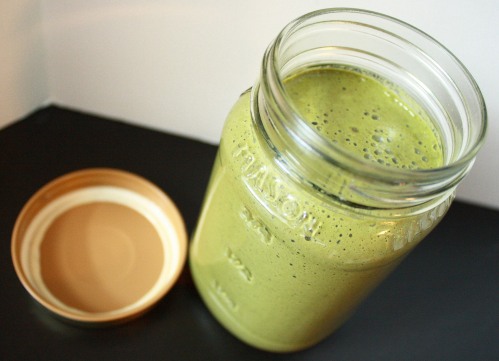
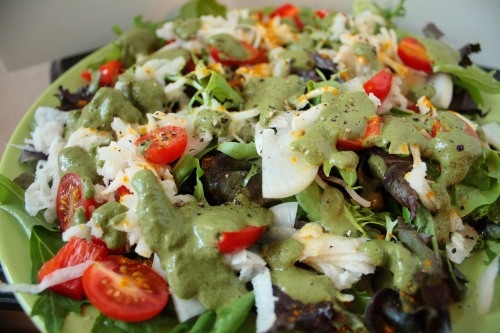
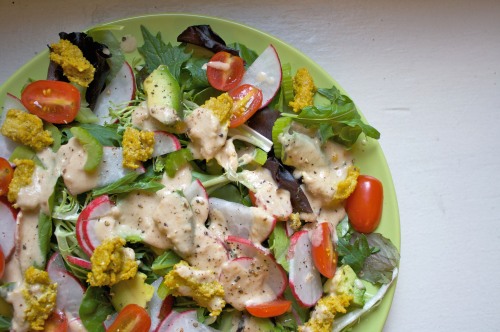 This salad is made with a Curry Paté and topped with Creamy Tahini Dressing.
This salad is made with a Curry Paté and topped with Creamy Tahini Dressing.